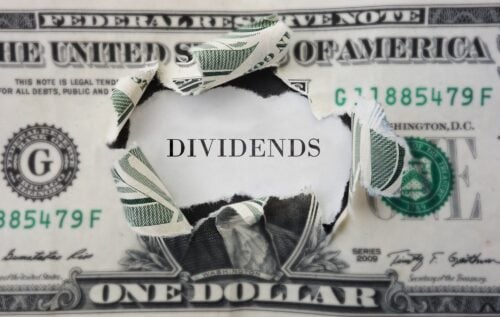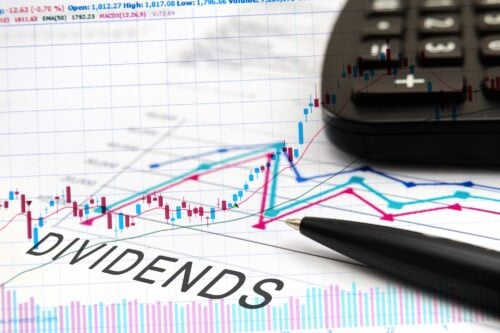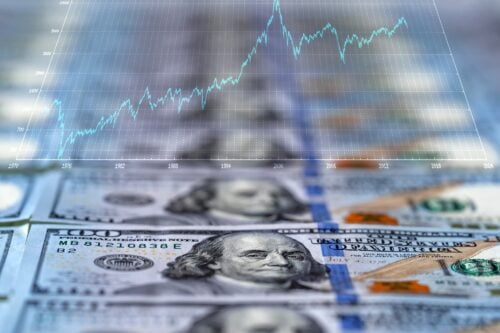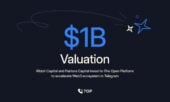Dividend stocks are a good way to get regular income with higher stability and safety than growth stocks. But how many dividend stocks should you own to get a healthy income, or even retire? We did the math, and here’s our answer.
About Dividend Stocks
Dividend stocks are securities that regularly pay money in the form of dividends to their investors.
These are usually firms with strong, established businesses and a solid track record of sharing earnings with stockholders.
Dividends are a good source of comparatively risk-free and steady income independent of rising and falling stock prices.
Growth shares are often contrasted with dividend-paying stocks. These are perceived to offer a high potential for capital appreciation, and most do not give out regular dividends.

Investors putting their money in growth stocks hope to see the share price go up significantly, which grows their wealth in the long run.
In comparison, dividend stock investors are looking for a regular, steady flow of income.
Can You Live Off Dividend Stocks?
Yes, you can live purely on a dividend portfolio, but it would require an absurdly large amount to be put into dividend stocks to do it.
Additionally, it may not be the best way to invest money. Optimizing the portfolio for total returns might be better than just dividend flows.
Think about it this way: let’s say that you earn a $100 dividend from 10 stocks worth $100 each and then reinvest it back.
The total portfolio investment thus becomes $1,100 ($100 per stock x 10 stocks + $100 dividend).
In effect, this is the same as if the stock price went up to $110 per share ($1,100/10 shares). Money-wise, there is no difference between the two scenarios.
The only advantage might be that dividends are slightly more predictable, though payout ratios also go up and down.
With smart investing, most traders tend to make better returns through a combination of asset appreciation and dividend yields rather than just one approach.

Related: The 10 Best Monthly Dividend Stocks For Income Investors
Do You Pay Taxes on Dividends?
Yes, dividends are taxable. The tax rate applied depends on whether the income is classified as ordinary or qualified.
While ordinary dividends are taxed at regular income tax rates, qualified ones are taxed at preferential long-term capital gains rates.
Such dividends have their own tax table, which currently sets a maximum rate of 20% for the year.
Moreover, the tax rate on qualified dividends for those whose income is below $80,000 a year is zero.
Dividend-paying companies identify the type for each payout and report it on the 1099-DIV form.
If this amount exceeds $1,500, it needs to be reported on Schedule B of the Federal Tax Returns.
Related: What Are The Taxes On REIT Dividends?
How Many Dividend Stocks Should I Own?
Some experts suggest that owning between 20 to 30 stocks is usually enough to build a dividend portfolio.
However, there is no hard and fast rule, and an investor can have any number of stocks they are comfortable with, whether it be just one or 50.
The quantity of shares needed to build a strong dividend portfolio depends on several factors, such as:

- Risk tolerance
- How many stocks can one monitor
- Sectors to cover
- Investing strategy, and so on.
For example, investors who do not mind a high-risk strategy might focus on a small set of shares that offer high dividend yields, but others may want a diversified portfolio.
A dividend strategy also needs regular monitoring and recalibration of the stocks. An investor should not opt to buy more stocks than they can effectively track regularly.
Sectoral preferences can make a difference because some sectors have only a few companies that pay dividends, whereas others might have a larger set of choices.
How Much Dividend Is Considered High?
More than a 4% dividend yield is considered high, and anything near the 10% mark is dangerously so.
An extremely high yield is not always a good thing because it might indicate that the yield is unsustainable in the long term.
Moreover, such high yields may also show that the stock price is falling due to selling off from investors.
As the security price goes down, it drives the yield percentage higher. For dividend investors, such high yields should ring a cautionary bell.
It is important to analyze the firm’s fundamentals further and see whether it is capable of such high payouts in the future.
How Many Dividend Stocks Should I Own to Retire?
The median household in the US would need about $850,000 invested in a strong dividend income portfolio to retire and live off purely dividend income.
Note that this assumes a higher-than-average 5% yield.
The calculation is based on a median household income of $76,000, about $5,000 worth of 401k withdrawals, $20,000 in social security benefits, and $10,000 in earnings from other sources.
How many dividend stocks are needed for these kind of earnings can vary significantly depending on several factors, including:
- Income needs
- Social security benefits
- 401k withdrawals
- Earnings come from other sources of income like pensions or other assets
- Actual dividend yield obtained
As you can see, it is very difficult to offer a general answer to the question. It can only be done on a case-to-case basis.

Can You Live off Dividends of 1 Million Dollars?
At about a 4% dividend yield, a $1 million investment in a dividend stock portfolio would yield an annual income of just about $40,000 (pre-tax).
Assuming no other sources of money, that’s nearly half the median annual household income. It would probably not be able to cover the entire expenses for a family.
However, it might go a long way, especially if there are other sources of earnings.
For a comfortable lifestyle, a $2 million investment would be the right amount to invest, assuming the entire sum is allocated to only dividend stocks.
Can You Make Millions With Dividend Stocks?
Theoretically, yes, but making millions through dividend stocks requires investing a huge amount of money in them.
For example, assuming an above-average yield of 5%, even a $20 million investment in dividend stocks would only generate a $1 million earning per year.
What’s more, dividend income is taxable at federal income tax rates, which would take a big chunk of money from this.
Twenty million is an absurdly high amount of money for most people. Even if this kind of money is available, investing it all in any single asset class is not the best idea.
It would probably be better to invest investing in a diversified portfolio across asset classes, including stocks, mutual funds, ETFs, real estate, and so on.

How Can I Earn $4,000 a Month in Dividends?
To earn $4,000 a month, investing about $1.6 million in high-quality dividend stocks would be required.
However, note that it depends on how much yield the shares are offering.
The best way to get to this amount is to start investing slowly each month, taking regular increases each year.
Regularly reinvesting back the dividend payments being generated will also help build up the total amount.
How Long Should You Keep Dividend Stocks?
From a taxation standpoint, holding a dividend stock for at least 61 days out of the 121-day period that extends before and after the dividend payout is important.
If this condition is not met, the dividend income gets taxed at regular income tax rates, which may be as high as 28%.
However, if you do meet the criteria, the money gets taxed at a lower rate.
Keep in mind that for the 61-day period, the date on which the share was bought is not counted, but the day on which it is disposed of is.
What Is the Longest Paying Dividend Stock?
Here are five companies that have regularly paid dividends to investors for over a hundred years:
- General Mills, Inc. (GIS) – Since 1898
- Johnson Controls Inc. (JCI) – Since 1887
- Church & Dwight Co., Inc. (CHD) – Since 1901
- Exxon Mobil Corporation (XOM) – Since 1882
- Eli Lilly and Co (LLY) – Since 1885
All of these stocks have good dividend payout ratios and are expected to continue offering dividends to shareholders for the next several years as well.
What Is the Fastest Way to Grow Dividend Income?
There are several strategies that might help grow dividend income faster.
Regularly investing free cash flow, reinvesting dividends, actively seeking high-yield firms, monitoring and recalibrating the portfolio, and dollar cost averaging are some of the ideas that might work well.
Below we have discussed these in more detail.

Invest Free Cash
Whether it is a little extra from a side hustle or a yearly bonus you get on the job, putting in as much money as you can into dividend stocks could be beneficial.
By putting in every small bit that can be spared after expenses and liabilities, the total dividend portfolio will keep growing regularly.
Invest in Companies That Offer Dividend Increases
There are several shares that offer regular growth on dividend payouts.
Investing in such firms automatically increases overall dividend income without putting in additional cash.
In fact, a few companies have been regularly increasing yields for many years.
These are some of the best dividend stocks to own, also known as Dividend Kings or Dividend Aristocrats.
Reinvest Dividends
It might seem a bit counterintuitive to invest back in dividends, but it is one of the fastest ways to grow income from them.
If the earnings are not absolutely essential for your everyday expenses, reinvesting dividend income is an easy way to grow the overall portfolio.
It is possible to do this through several means. While some shares offer automatic Dividend Reinvestment Plans (DRIPs), others might not.
In such cases, an investor can plan for automatic reinvestments through a stock broker or buy the share manually every time it pays out dividends.
Monitor The Portfolio
A company’s dividend yield can fluctuate significantly over time, so keeping tabs on the portfolio is important.
Select firms that pay better dividends and discard those that regularly reduce their payouts. This will make sure that the average yield remains high.

Dollar-Cost Averaging
Dollar-cost averaging is an approach that involves buying a share using a fixed amount of money at a pre-decided, regular interval, such as a month or a quarter.
This is actually one of the most well-known approaches to retail investing.
It takes into account the fact that it is difficult for most people to spend time analyzing the stock market to decide the best time to buy.
Using this approach reduces buyers’ overall long-term purchase cost while saving them the effort needed to “time the market.”
In fact, it is the same mechanism that most people use when investing in a 401(k).
They simply choose which plan to invest in, and then a fixed amount gets deducted from their salary monthly to invest in that plan.
Final Thoughts
There’s a certain charm to getting dividend income at regular intervals, as the money goes straight into your bank accounts instead of as a notional gain in stock prices.
However, the math does not work differently in either case – whether the returns come one way or another, it is pretty much the same.
The only benefit is perhaps that dividends are slightly more reliable. However, as with all things in the stock market, risk and rewards are proportional.
If you have decided that earning dividends will form a big part of your investing strategy, most financial experts suggest buying between 20-30 dividend stocks.
This varies a lot depending on the sectors to invest in, risk tolerance, dividend investing strategy, and other factors.
Lastly, making a retirement corpus or an otherwise big monthly sum purely through dividend income is very difficult.
It requires regular, disciplined investing and a large capital outlay which may not be apt for most people.
You might also like:
Check Out These 4 Dividend Stocks Yielding Over 4%!
These 3 Renewable Energy Dividend Stocks Could Help You Earn Passive Income


 Tags:
Tags:










